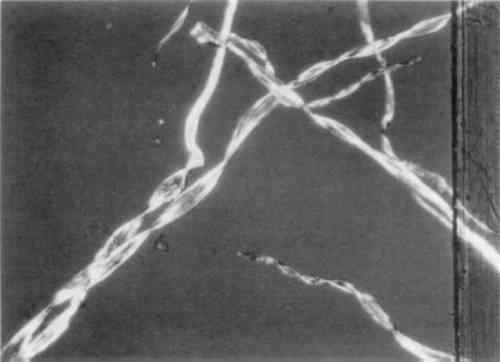THE EXAMINATION AND CONSERVATION TREATMENT OF THE LIBRARY OF CONGRESS HARKNESS 1531 HUEJOTZINGO CODEXSYLVIA RODGERS ALBRO, & THOMAS C. ALBRO
4 SILKED PAGESTHE FIRST and last pages of the manuscript had become separated from the sewn text many years ago. Due to their greater exposure to handling and the lack of protective covers in the structure of the manuscript, they had sustained the most damage and were first selected by the Library of Congress to receive treatment by the Government Printing Office in the 1940s (Library of Congress case file, n.d.). Large areas of loss in each leaf were filled with laid paper before Cr�peline (a French close-weave transparent silk) was applied with a starch adhesive to both sides of the leaves. The leaf paper was the same as the rest of the sewn manuscript; however, the treatment had greatly altered its appearance and texture. The silking was done on top of considerable surface soil. Sheets had a placemat quality and were brittle and stiff. Corners of the paper bent easily. Surface pH of these leaves measured approximately 4.0. Because the pH meter records only surface pH, it was difficult to determine whether the measurement referred only to the applied silk or to the paper underneath as well. When compared to a new, unused piece of Cr�peline from the same source (pH 4.6), the old fabric had discolored to a dark brown. Original sewing holes could be detected in transmitted light examination. In spite of drawbacks, silking did save these manuscript leaves from further loss in the last 45 years. Examination of the microfilm from the 1940s showed that untreated leaves in the manuscript had subsequently lost fragments of text. Nevertheless, a better solution for the treatment of the manuscript text was necessary. 4.1 DRAWINGSThe drawings were carefully and colorfully executed on fibrous native Mexican papers of various sizes, all larger than the manuscript text paper. Upon examination two distinctly
Both papers are skillfully made, regular and even in texture. Dimensions vary from 19.7 � 48.3 cm to 44.5 � 45.7 cm. The amatl paper is made from soaked and boiled inner bark fiber pounded with stone and looks like a highly worked and refined tapa cloth. It is light brown in color. A texture of corrugated lines from the stones used for beating is a feature of this stretchy, delicate paper. The maguey paper, made from the inside of the leaves of the agave cactus, has a more silvery white color than the amatl and a thicker, more even texture. It is also a beaten paper but does not have the corrugated lines of the amatl. The authors gained a fine appreciation for the craft of the Huejotzingo Indian papermakers after attempting with only partial success to reproduce similar papers from Mexican amatl fibers obtained from a modern papermaker.11 Colors used in the Nahuatl drawings were black, red, yellow, orange, green, brown, and blue. A white pigment, identified as calcium carbonate, was mixed in with many of the colors. The black is identified as a very fine charcoal. Polarized light microscopy was used to identify these pigments. Other colors appear to be organic in nature and are more difficult to identify precisely. Original sources suggest a varied organic palette for the scribe or artist of the Aztec period (de Sahag�n 1963, pt. 12:239–46). The vivid red pigment that appears in many of the designs is probably cochineal, a color noted for its widespread use in this area of Mexico (fig. 8) (Aguilera 1985, 92; de Sahag�n 1963, 12:239–46).12 Sources describe the pigment binder most commonly used by Indians in Mexico during the colonial period and before as tzacuhtli, a natural adhesive similar to gum arabic or cherry gum, obtained from the roots of an orchid plant (Epidendrum pastoris La Llave et Lex.) (Mart�nez-Cortez 1970; Hern�ndez 1942–46, 1: chap. 128, 2: chaps. 80, 84). Folding and unfolding the drawings during use created a need for consolidation of crumbling pigment in the creases. In areas not directly affected by the stresses of use, the pigments are well adhered to the paper. Case file notes from the Library of Congress Manuscript Division indicate that the manuscript was on permanent exhibit for 12 years, from 1930 to 1942. Considering that the pigments are primarily organic, it is remarkable that the colors remain bright and vibrant despite this long period of exhibition. Sewing the drawings into the Spanish text resulted in mixed benefits for their preservation. They were folded to fit the smaller format of the text, creating pronounced creases and eventually tears and holes. On the other hand, they were never separated from their descriptive material or from each other as so many other drawings of the period have been, so their associative relationship with the text was preserved. Their placement within the manuscript protected them from exposure to light and dust. Examination with raking light revealed previous folds in the drawing papers, indicating a possible accordion pleat format before they were sewn into the manuscript. Surface pH measurement of the papers varied from 4.0 to 4.2. |

